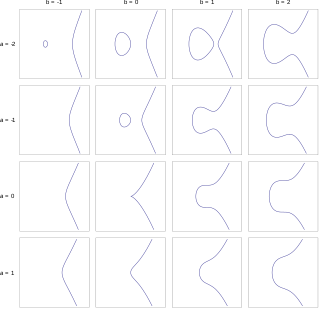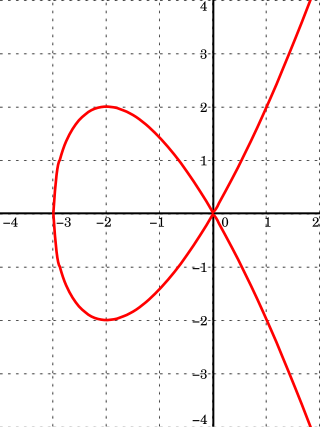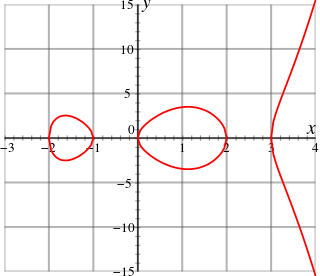Elliptic-curve cryptography (ECC) is an approach to public-key cryptography based on the algebraic structure of elliptic curves over finite fields. ECC allows smaller keys to provide equivalent security, compared to cryptosystems based on modular exponentiation in Galois fields, such as the RSA cryptosystem and ElGamal cryptosystem.

In mathematics, an elliptic curve is a smooth, projective, algebraic curve of genus one, on which there is a specified point O. An elliptic curve is defined over a field K and describes points in K2, the Cartesian product of K with itself. If the field's characteristic is different from 2 and 3, then the curve can be described as a plane algebraic curve which consists of solutions (x, y) for:
The Lenstra elliptic-curve factorization or the elliptic-curve factorization method (ECM) is a fast, sub-exponential running time, algorithm for integer factorization, which employs elliptic curves. For general-purpose factoring, ECM is the third-fastest known factoring method. The second-fastest is the multiple polynomial quadratic sieve, and the fastest is the general number field sieve. The Lenstra elliptic-curve factorization is named after Hendrik Lenstra.

In mathematics, particularly in algebraic geometry, complex analysis and algebraic number theory, an abelian variety is a projective algebraic variety that is also an algebraic group, i.e., has a group law that can be defined by regular functions. Abelian varieties are at the same time among the most studied objects in algebraic geometry and indispensable tools for research on other topics in algebraic geometry and number theory.

In mathematics, an affine algebraic plane curve is the zero set of a polynomial in two variables. A projective algebraic plane curve is the zero set in a projective plane of a homogeneous polynomial in three variables. An affine algebraic plane curve can be completed in a projective algebraic plane curve by homogenizing its defining polynomial. Conversely, a projective algebraic plane curve of homogeneous equation h(x, y, t) = 0 can be restricted to the affine algebraic plane curve of equation h(x, y, 1) = 0. These two operations are each inverse to the other; therefore, the phrase algebraic plane curve is often used without specifying explicitly whether it is the affine or the projective case that is considered.

In mathematics, birational geometry is a field of algebraic geometry in which the goal is to determine when two algebraic varieties are isomorphic outside lower-dimensional subsets. This amounts to studying mappings that are given by rational functions rather than polynomials; the map may fail to be defined where the rational functions have poles.

In mathematics, Felix Klein's j-invariant or j function, regarded as a function of a complex variable τ, is a modular function of weight zero for special linear group SL(2, Z) defined on the upper half-plane of complex numbers. It is the unique such function that is holomorphic away from a simple pole at the cusp such that

In algebraic geometry, a hyperelliptic curve is an algebraic curve of genus g > 1, given by an equation of the form where f(x) is a polynomial of degree n = 2g + 1 > 4 or n = 2g + 2 > 4 with n distinct roots, and h(x) is a polynomial of degree < g + 2 (if the characteristic of the ground field is not 2, one can take h(x) = 0).
In mathematics, an algebraic torus, where a one dimensional torus is typically denoted by , , or , is a type of commutative affine algebraic group commonly found in projective algebraic geometry and toric geometry. Higher dimensional algebraic tori can be modelled as a product of algebraic groups . These groups were named by analogy with the theory of tori in Lie group theory. For example, over the complex numbers the algebraic torus is isomorphic to the group scheme , which is the scheme theoretic analogue of the Lie group . In fact, any -action on a complex vector space can be pulled back to a -action from the inclusion as real manifolds.
In mathematics, complex multiplication (CM) is the theory of elliptic curves E that have an endomorphism ring larger than the integers. Put another way, it contains the theory of elliptic functions with extra symmetries, such as are visible when the period lattice is the Gaussian integer lattice or Eisenstein integer lattice.

In algebraic geometry, a Kummer quartic surface, first studied by Ernst Kummer, is an irreducible nodal surface of degree 4 in with the maximal possible number of 16 double points. Any such surface is the Kummer variety of the Jacobian variety of a smooth hyperelliptic curve of genus 2; i.e. a quotient of the Jacobian by the Kummer involution x ↦ −x. The Kummer involution has 16 fixed points: the 16 2-torsion point of the Jacobian, and they are the 16 singular points of the quartic surface. Resolving the 16 double points of the quotient of a torus by the Kummer involution gives a K3 surface with 16 disjoint rational curves; these K3 surfaces are also sometimes called Kummer surfaces.
In mathematics, an algebraic surface is an algebraic variety of dimension two. In the case of geometry over the field of complex numbers, an algebraic surface has complex dimension two and so of dimension four as a smooth manifold.
In mathematics, the canonical bundle of a non-singular algebraic variety of dimension over a field is the line bundle , which is the nth exterior power of the cotangent bundle on .
In mathematics, a rational variety is an algebraic variety, over a given field K, which is birationally equivalent to a projective space of some dimension over K. This means that its function field is isomorphic to
In algebraic geometry, supersingular elliptic curves form a certain class of elliptic curves over a field of characteristic p > 0 with unusually large endomorphism rings. Elliptic curves over such fields which are not supersingular are called ordinary and these two classes of elliptic curves behave fundamentally differently in many aspects. Hasse (1936) discovered supersingular elliptic curves during his work on the Riemann hypothesis for elliptic curves by observing that positive characteristic elliptic curves could have endomorphism rings of unusually large rank 4, and Deuring (1941) developed their basic theory.
In mathematics, the Enriques–Kodaira classification groups compact complex surfaces into ten classes, each parametrized by a moduli space. For most of the classes the moduli spaces are well understood, but for the class of surfaces of general type the moduli spaces seem too complicated to describe explicitly, though some components are known.
In number theory, the classical modular curve is an irreducible plane algebraic curve given by an equation
Supersingular isogeny Diffie–Hellman key exchange is an insecure proposal for a post-quantum cryptographic algorithm to establish a secret key between two parties over an untrusted communications channel. It is analogous to the Diffie–Hellman key exchange, but is based on walks in a supersingular isogeny graph and was designed to resist cryptanalytic attack by an adversary in possession of a quantum computer. Before it was broken, SIDH boasted one of the smallest key sizes of all post-quantum key exchanges; with compression, SIDH used 2688-bit public keys at a 128-bit quantum security level. SIDH also distinguishes itself from similar systems such as NTRU and Ring-LWE by supporting perfect forward secrecy, a property that prevents compromised long-term keys from compromising the confidentiality of old communication sessions. These properties seemed to make SIDH a natural candidate to replace Diffie–Hellman (DHE) and elliptic curve Diffie–Hellman (ECDHE), which are widely used in Internet communication. However, SIDH is vulnerable to a devastating key-recovery attack published in July 2022 and is therefore insecure. The attack does not require a quantum computer.
In mathematics, the supersingular isogeny graphs are a class of expander graphs that arise in computational number theory and have been applied in elliptic-curve cryptography. Their vertices represent supersingular elliptic curves over finite fields and their edges represent isogenies between curves.

Andrew Victor Sutherland is an American mathematician and Principal Research Scientist at the Massachusetts Institute of Technology. His research focuses on computational aspects of number theory and arithmetic geometry. He is known for his contributions to several projects involving large scale computations, including the Polymath project on bounded gaps between primes, the L-functions and Modular Forms Database, the sums of three cubes project, and the computation and classification of Sato-Tate distributions.
































